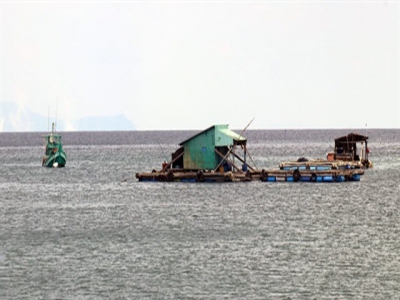Kiên Giang expands marine aquaculture on industrial scale

KIÊN GIANG — The Cửu Long (Mekong) Delta province of Kiên Giang will expand marine aquaculture on an industrial scale in an aim to improve residents' income and protect the environment on islands and coastal areas from now until 2030.
Breeding marine fish in floating cages on Phú Quốc Island in the southern province of Kiên Giang Province. —VNA/VNS Photo Lê Huy Hải
The province plans to set aside zones for marine aquaculture in Phú Quốc, Kiên Hải and Kiên Lương districts, Hà Tiên City, Long Xuyên Quadrangle and U Minh Thượng areas, according to its Department of Agriculture and Rural Development.
Nguyễn Văn Tâm, director of the department, said the province would develop marine aquaculture in combination with fishery services and tourism.
The province’s marine aquaculture breeds mostly marine fish and bivalve mollusks, but its economic efficiency is not high, according to Tâm.
The province’s marine aquaculture has high potential but is small scale and has inadequate infrastructure.
Most marine fish breeders are households that use small fish to feed marine fish, causing pollution risks and unsustainable development.
The province lacks factories for producing animal feed as well as factories for processing harvested marine fish. There is also a shortage of establishments that produce marine fish fry.
As of this month, the province has 3,464 floating cages that breed various kinds of marine fish species, up 27 per cent against the same period last year.
The marine fish species include cobia, grouper, black banded trevally and white pomfret.
Last year, the province bred nearly 21,800ha of bivalve mollusks with a total output of 66,000 tonnes.
The bivalve mollusks, mostly mud clam, blood cockles and green mussels, are bred in alluvial grounds, shrimp ponds and mangrove forests.
The province estimates that it will be breeding bivalve mollusks on an area of 22,700ha with total output of 78,100 tonnes this year, according to the department.
The province also has about 50ha of oyster farming area for harvesting pearls in Phú Quốc District. Private enterprise Ngọc Hiền Pearl has invested in the area that produced about 250,000 pearls last year. The district’s pearl farming has contributed to tourism.
In recent years, the province has called on companies to invest in farming marine fish with advanced techniques.
The Trấn Phú Trading and Import-Export Co Ltd in Phú Quốc District is breeding white pomfret and red drum in floating cages with Norwegian techniques.
In the 2016-18 period, the company had four such floating cages with a total output of 100 tonnes a year. This year, the company added eight floating cages.
In July, the province gave approval to the Mavin Group to invest in breeding marine fish in Kiên Hải District for export. The project will cover 2,000ha of surface water off the coast of Kiên Hải and cost US$30 million.
The project is scheduled to operate in 2021 and will produce 30,000 tonnes of marine fish a year.
The province has nearly 200km of coast and favourable natural conditions for breeding fish in floating cages
Related news
 Essential oils shown to improve trout performance
Essential oils shown to improve trout performance New research has demonstrated that rainbow trout fed a diet supplemented with thyme essential oil had improved growth, weight gain, immune response and disease
 The machine learning software that improves feeding efficiency
The machine learning software that improves feeding efficiency Umitron has launched “the world’s first real-time ocean-based fish appetite detection system” on the European aquaculture market today.
 Shrimp exports reach $1.93 billion in first eight months of 2019
Shrimp exports reach $1.93 billion in first eight months of 2019 Statistics from the Directorate showed that the country now has 689,516 hectares of shrimp ponds, increasing 0.5 percent year-on-year.